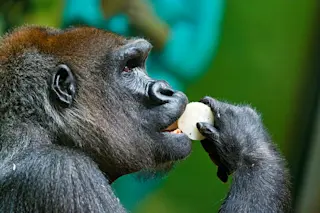By now, it’s becoming pretty clear that non-human primates are pretty musical: Gorillas have been shown to have individual tastes in music, and chimpanzees are pretty good drummers. In this study, the researchers observed wild gorillas in the Republic of Congo. They found that the gorillas produce certain vocalizations, which the researchers call “singing” or “humming”, only when they are eating certain foods. The authors speculate that the calls could help coordinate group behaviors… but we prefer to believe that this is the gorilla version of “om nom nom”. Wondering what gorilla humming sounds like? Check out the clips below!
Food-Associated Calling in Gorillas (Gorilla g. gorilla) in the Wild
“Many nonhuman primates produce food-associated vocalizations upon encountering or ingesting particular food. Concerning the great apes, only food-associated vocalizations of chimpanzees (Pan troglodytes) and bonobos (Pan paniscus) have been studied in detail, providing evidence that these vocalizations can be produced ...














